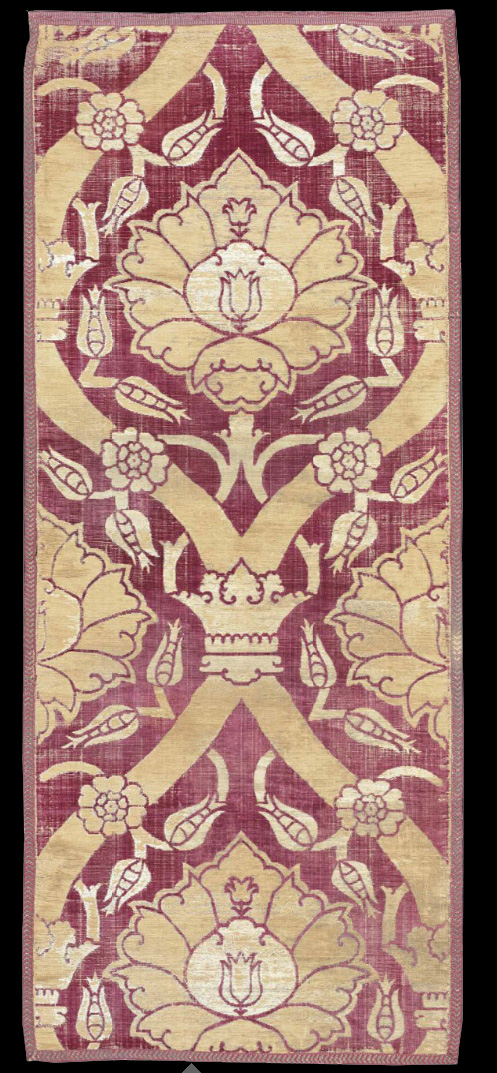|
AN OTTOMAN SILK VELVET AND METAL THREAD PANEL
BURSA OR ISTANBUL,
TURKEY, FIRST HALF 17TH CENTURY
Price Realized £11,250 ($18,113)
Estimate £10,000 - £15,000 ($16,110 - $24,165)
Sale Information
Christies SALE 5708
ART OF THE ISLAMIC AND INDIAN
WORLD
4 October 2012
London, King Street
Lot Description
AN OTTOMAN SILK VELVET AND METAL THREAD PANEL
BURSA
OR ISTANBUL, TURKEY, FIRST HALF 17TH CENTURY
The red velvet ground
with silver and gold ground palmettes within ogival lattice strapwork
linked by crown motifs and filled with hatayi flowers, the medallions
circled by vine issuing tulips and further rosettes, in later applied
chevron-patterned border, backed with hessian with four hanging loops
60 x 25¼in. (152.4 x 64.2cm.)
Pre-Lot Text
PROPERTY FROM THE COLLECTION OF THE LATE D. LUIS BRAMÃO
Lot Notes
This impressive velvet combines elements imported from
Italian textiles with motifs that are recognizably from the Ottoman
decorative repertoire of the 16th and 17th centuries. A velvet in the
Louvre, catalogued as 'Italian manufacture for the Ottoman market',
provides a likely precedent for the group of textiles to which ours
belongs (inv. MAO 932, Istanbul, Isfahan, Delhi. 3 Capitals of Islamic
Art. Masterpieces from the Louvre Collection, exhibition catalogue, 2008,
no. 12, pp.105-06). It is similarly decorated with large palmettes
contained within an ogival lattice linked by crowns.
It is likely
that textiles bearing crowns, with their association with royalty, were
sent as gifts to the Ottoman palace, appreciated by the Sultan, and
subsequently commissioned locally. Of note is that one of only two
cut-velvet imperial kaftans to have survived in the Topkapi Palace
collections bears an almost identical design, supporting this royal
suggestion (N. Atasoy, W.B.Denny L.W.Mackie and H.Tezcan, Ipek. The
Crescent & The Rose, London, 2001, fig. 88, p.136). That is dated to the
first half of the 17th century.
A miniature from the second volume
of the Hünername, written in honour of Sultan Süleyman the Magnificent by
the writer Seyyid Lokman, which depicts Sutlan Süleyman hunting at the
Filibe (Plovdiv) palace shows two important aghas of the Has Oda, or Privy
Chamber, wearing kaftans clearly patterned with medallions joined by
crowns. They are the çuhadar (in charge of the sultan's outer garments)
and the silahdar (sword-bearer) (3 capitals of Islamic Art, op. cit.,
p.105). Similarly in the Kiyâfetü'l-insâniye fi email-I Osmaniye (Human
Physiognomy Concerning the Person Dispositions of the Ottomans), written
by Seyyid Lokman Ashuri in 1579 and illustrated by Nakka Osman, early
Ottoman Sultans are portrayed in crown-embellished robes (H.1563, David J.
Roxburgh (ed.), Turks. A Journey of a Thousand Years, 600-1600, exhibition
catalogue, London, 2005, fig. 49, pp.270-71). The depiction of such robes
being worn by the highest elite - Sultans and members of the Privy Chamber
that surrounded them - highlights the royal symbolism of the design.
What are plainly Italian elements in the Louvre textile have become
distinctly Ottoman in the present example and in the Topkapi kaftan. The
Italian caper leaves for instance, which are a feature foreign to Ottoman
art (found on a pattern for an Italian textile, dated 1555, N. Atasoy et
al, op. cit., fig. 37, p.183), have here become familiar tulips. An
Ottoman velvet, on green ground, but similarly worked with a lattice
linked with crowns, is in the Keir Collection (B.W.Robinson (ed.), Islamic
Art in the Keir Collection, London, 1988, no.T56, pp.105-06). That example
is dated to the mid 16th century but in the fussiness of the design bears
closer resemblance to the Italian precursors than does ours. Closer to
ours are two panels in the Sadberk Hanim Müzesi, dated to the second half
of the 17th century (Hülya Bilgi, Çatma ve Kemha. Ottoman Silk Textiles,
exhibition catalogue, Istanbul, 2007, no. 21, pp.66-67). Those examples,
like ours, shows the development of the design which has simplified and
become even more recognizably Ottoman. Other similar panels of hatayi
palmettes with four crowns on a lattice are in the Abegg-Siftung,
Riggisberg-Berne (inv.no.2213); Bargello Museum, Florence (inv.no.103F);
Musée Historique des Tissus, Lyon (inv.no.27.887); Royal Ontario Museum,
Toronto (inv.no.972,415.222, a fragment) and Benaki Museum (inv.no.3812).
A liturgical vestment formed of çatmas with crown motifs is in the Lublin
Museum of Ecclesiastic Art in Poland (Nevber Gürsu, The Art of Turkish
Weaving. Designs through the Ages, Istanbul, 1988, no.72, p.91).
So
striking is the design that in the 19th century, a closely related pattern
on a textile, of a palmette with two crowns, served as the model for the
Scottish carpet and textile manufacturers Alexander Morton & Co. An
example of this is in the Art Institute of Chicago (Ada Turnbull Hertle
Endowment, inv. 1988.106). |

